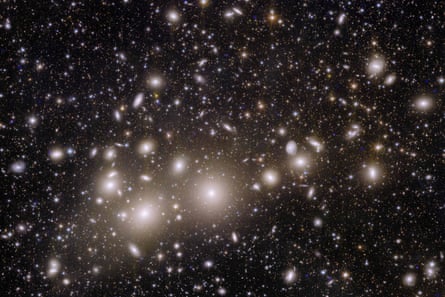
The Euclid Space Telescope has returned its first images in a mission that promises to lift the veil on the “dark universe”.
The European Space Agency’s (Esa) €1bn (£850m) mission focuses on dark matter and dark energy, which together make up 95% of the universe, but whose nature is almost completely mysterious. The first images show the Perseus galaxy cluster and the Horsehead Nebula in dazzling detail and capture nearly 100,000 galaxies in a single shot, showcasing the telescope’s unparalleled ability to make razor-sharp observations across a vast expanse of space.
Ultimately, the telescope, which can detect galaxies 10 billion light-years away, aims to create the largest 3D cosmic map ever. This will allow astronomers to infer the large-scale distribution of dark matter and reveal the influence of dark energy in the early universe. Dark matter pervades the universe and acts as a cosmic glue that holds galaxies together, while dark energy is the name given to the mysterious force that is believed to accelerate the expansion of the universe.
Professor Carol Mundell, ESA’s director of science, said the mission, which launched in July, would push the frontiers of scientific knowledge into uncharted territory “beyond Einstein”.

“As humans, we have been able to figure out how 5% of the universe works, and we have also discovered that there is another 95% that is still unknown to us,” she said. “We can’t travel to the edge of the universe to investigate, but we can bring those images back to Earth and study them on computers – for just 1.4 billion euros. I think it’s magical.”
Over the next six years, Euclid will observe about 8 billion galaxies using infrared and visible light across 36% of the night sky. In some cases, light from these distant objects passes close to dark matter on its journey toward Earth. When this happens, its gravitational field will bend the path of light, making the galaxies appear distorted in the final image.
Professor Mark Cropper from University College London, who led the design of Euclid’s optical camera, said: “The shape of the round background galaxy can be changed into the shape of a banana.” By analyzing the distortion patterns, astronomers were able to deduce a map of the distribution of dark matter across the night sky and over the history of the universe. “You do it like toast in a toast rack,” Cropper said. “First, you look at the distortion of nearby galaxies and count the dark matter in the first slice of toast. Then you go back to the next slice, farther and farther into the universe and go back in time.

The mission may not initially answer what dark matter is, but it should at least reveal where it is and how it behaves.
Researchers will also monitor the motion of galaxies to build an accurate picture of competing gravitational forces, which cause galaxies to cluster together, and dark energy, which drives the accelerating expansion of space. This will allow scientists to see, for the first time, how dark energy worked in the early universe.
“Dark matter holds galaxies together and makes them spin faster than visible matter alone can explain,” Mundell said. Dark energy is driving the accelerating expansion of the universe. Euclid will for the first time allow cosmologists to study these dark, competing mysteries together.
“We have never seen astronomical images like this before, with so much detail,” added Rene Lorig, ESA’s Euclid project scientist. “They are even more beautiful and clearer than we had hoped, showing us many previously unseen features in known regions.” “From the nearby universe. We are now ready to observe billions of galaxies and study their evolution over cosmic time.”

“Web maven. Infuriatingly humble beer geek. Bacon fanatic. Typical creator. Music expert.”





More Stories
Scientists confirm that monkeys do not have time to write Shakespeare: ScienceAlert
SpaceX launches 23 Starlink satellites from Florida (video and photos)
A new 3D map reveals strange, glowing filaments surrounding the supernova